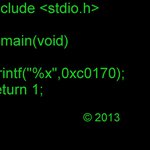The official Mbed 2 C/C++ SDK provides the software platform and libraries to build your applications.
Dependents: hello SerialTestv11 SerialTestv12 Sierpinski ... more
mbed 2
This is the mbed 2 library. If you'd like to learn about Mbed OS please see the mbed-os docs.
TARGET_TB_SENSE_1/TOOLCHAIN_IAR/rail_ble.h
- Committer:
- AnnaBridge
- Date:
- 2018-11-08
- Revision:
- 171:3a7713b1edbc
- Parent:
- TARGET_TB_SENSE_1/TARGET_Silicon_Labs/TARGET_SL_RAIL/efr32-rf-driver/rail/ble/rail_ble.h@ 167:84c0a372a020
File content as of revision 171:3a7713b1edbc:
/***************************************************************************//**
* @file rail_ble.h
* @brief The BLE specific header file for the RAIL library.
* @copyright Copyright 2016 Silicon Laboratories, Inc. www.silabs.com
******************************************************************************/
#ifndef __RAIL_BLE_H__
#define __RAIL_BLE_H__
// Get the standard include types
#include <stdint.h>
#include <stdbool.h>
// Get the RAIL specific structures and types
#include "rail_types.h"
#ifdef __cplusplus
extern "C" {
#endif
/// @addtogroup BLE
/// @ingroup Protocol_Specific
/// Accelerator routines for Bluetooth Low Energy (BLE).
///
/// The APIs in this module help take care of configuring the radio for BLE
/// operation and provide some additional helper routines necessary for
/// normal BLE send/receive that aren't available directly in RAIL. All normal
/// RAIL APIs should be used to setup the application; however,
/// RAIL_ConfigChannels() and RAIL_ConfigRadio() should not be called to setup
/// the PHY. Instead, the RAIL_BLE_Config* APIs should be used to setup the
/// 1Mbps, 2Mbps, or Coded PHY configuration needed by the application. These
/// APIs will configure the hardware and also configure the set of valid BLE
/// channels.
///
/// To implement a standard BLE link layer you will also need to handle tight
/// turnaround times and send packets at specific instants. This can all be
/// managed through general RAIL functions like RAIL_ScheduleTx(),
/// RAIL_ScheduleRx(), and RAIL_SetStateTiming(). See the full RAIL API for more
/// useful functions.
///
/// A simple example of how to setup your application to be in BLE mode is shown
/// below. Note that this will put the radio on the first advertising channel
/// with the advertising Access Address. In any full featured BLE application you
/// will need to use the RAIL_BLE_ConfigChannelRadioParams() function to change
/// the sync word and other parameters as needed based on your connection.
///
/// @code{.c}
///
/// // RAIL Handle set at init time
/// static RAIL_Handle_t railHandle = NULL;
///
/// // Put the radio into receive on the first BLE advertising channel
/// int bleAdvertiseEnable(void)
/// {
/// // Call the BLE initialization function to load the right radio config
/// RAIL_BLE_Init(railHandle);
///
/// // Always choose the Viterbi PHY configuration if available on your chip
/// // for performance reasons.
/// RAIL_BLE_ConfigPhy1MbpsViterbi(railHandle);
///
/// // Configure us for the first advertising channel (Physical: 0, Logical: 37)
/// // The CRC init value and Access Address come from the BLE specification.
/// RAIL_BLE_ConfigChannelRadioParams(railHandle,
/// 0x555555,
/// 0x8E89BED6,
/// 37,
/// false);
///
/// // Start receiving on physical channel 0 (logical channel 37)
/// RAIL_StartRx(railHandle, 0, NULL);
/// }
/// @endcode
///
/// @{
/**
* @enum RAIL_BLE_Coding_t
* @brief The variant of the BLE Coded PHY
*/
RAIL_ENUM(RAIL_BLE_Coding_t) {
RAIL_BLE_Coding_125kbps = 0,
RAIL_BLE_Coding_125kbps_DSA = 1,
RAIL_BLE_Coding_500kbps = 2,
RAIL_BLE_Coding_500kbps_DSA = 3,
};
/**
* @struct RAIL_BLE_State_t
* @brief State structure for BLE.
*
* This structure must be allocated in application global read-write memory
* that persists for the duration of BLE usage. It cannot be allocated
* in read-only memory or on the call stack.
*/
typedef struct RAIL_BLE_State {
uint32_t crcInit; /**< The value used for CRC initialization. */
uint32_t accessAddress; /**< The access address used for the connection. */
uint16_t channel; /**< The logical channel used. */
bool disableWhitening; /**< Whether the whitening engine should be off. */
} RAIL_BLE_State_t;
/**
* Configure RAIL to run in BLE mode.
*
* @param[in] railHandle Handle for RAIL instance.
* This function will change your radio and channel configuration and other
* parameters to match what is needed for BLE. If you need to switch back to a
* default RAIL mode then you must call RAIL_BLE_Deinit() first. This function
* will configure the protocol output on PTI to \ref RAIL_PTI_PROTOCOL_BLE.
*/
void RAIL_BLE_Init(RAIL_Handle_t railHandle);
/**
* Take RAIL out of BLE mode.
*
* @param[in] railHandle Handle for RAIL instance.
* This function will undo some of the configuration that happens when you call
* RAIL_BLE_Init(). After this you can safely run your normal radio
* initialization code to use a non-BLE configuration. This function will \b
* not change back your radio or channel configurations so you must do this by
* manually reinitializing. This also resets the protocol output on PTI to \ref
* RAIL_PTI_PROTOCOL_CUSTOM.
*/
void RAIL_BLE_Deinit(RAIL_Handle_t railHandle);
/**
* Determine whether BLE mode is enabled or not.
*
* @param[in] railHandle Handle for RAIL instance.
* @return True if BLE mode is enabled and false otherwise.
* This function returns the current status of RAIL's BLE mode. It is enabled by
* a call to RAIL_BLE_Init() and disabled by a call to RAIL_BLE_Deinit().
*/
bool RAIL_BLE_IsEnabled(RAIL_Handle_t railHandle);
/**
* Switch the Viterbi 1Mbps BLE PHY.
*
* @param[in] railHandle Handle for RAIL instance.
* @return Status code indicating success of the function call.
*
* You can use this function to switch back to the defualt BLE 1Mbps PHY if you
* have switched to the 2Mbps or another configuration. You may only call this
* function after initializing BLE and while the radio is idle.
*/
RAIL_Status_t RAIL_BLE_ConfigPhy1MbpsViterbi(RAIL_Handle_t railHandle);
/**
* Switch the legacy non-Viterbi 1Mbps BLE PHY.
*
* @param[in] railHandle Handle for RAIL instance.
* @return Status code indicating success of the function call.
*
* You can use this function to switch back to the legacy BLE 1Mbps PHY if you
* have switched to the 2Mbps or another configuration. You may only call this
* function after initializing BLE and while the radio is idle.
*/
RAIL_Status_t RAIL_BLE_ConfigPhy1Mbps(RAIL_Handle_t railHandle);
/**
* Switch the Viterbi 2Mbps BLE PHY.
*
* @param[in] railHandle Handle for RAIL instance.
* @return Status code indicating success of the function call.
*
* You can use this function to switch back to the BLE 2Mbps PHY from the
* default 1Mbps option. You may only call this function after initializing BLE
* and while the radio is idle.
*
* @note Not all chips support the 2Mbps PHY. Consult your part's reference
* manual to be sure that it does before trying this.
*/
RAIL_Status_t RAIL_BLE_ConfigPhy2MbpsViterbi(RAIL_Handle_t railHandle);
/**
* Switch the legacy non-Viterbi 2Mbps BLE PHY.
*
* @param[in] railHandle Handle for RAIL instance.
* @return Status code indicating success of the function call.
*
* You can use this function to switch back to legacy BLE 2Mbps PHY from the
* default 1Mbps option. You may only call this function after initializing BLE
* and while the radio is idle.
*
* @note Not all chips support the 2Mbps PHY. Consult your part's reference
* manual to be sure that it does before trying this.
*/
RAIL_Status_t RAIL_BLE_ConfigPhy2Mbps(RAIL_Handle_t railHandle);
/**
* Switch to the BLE Coded PHY.
*
* @param[in] railHandle Handle for RAIL instance.
* @param[in] bleCoding The RAIL_BLE_Coding_t to use
* @return Status code indicating success of the function call.
*
* You can use this function to switch back to BLE Coded PHY from the default
* 1Mbps option. You may only call this function after initializing BLE and
* while the radio is idle. When using a BLE Coded PHY, the subPhy in
* RAIL_AppendedInfo_t marks the coding of the received packet. A subPhy of 0
* marks a 500kbps packet, and a subPhy of 1 marks a 125kbps packet.
*
* @note Not all chips support the BLE Coded PHY. Consult your part's reference
* manual to be sure that it does before trying this.
*/
RAIL_Status_t RAIL_BLE_ConfigPhyCoded(RAIL_Handle_t railHandle,
RAIL_BLE_Coding_t bleCoding);
/**
* Helper function to change BLE radio parameters.
*
* @param[in] railHandle Handle for RAIL instance.
* @param[in] crcInit The value to use for CRC initialization.
* @param[in] accessAddress The access address to use for the connection.
* @param[in] channel The logical channel that you're changing to. This is used to
* initialize the whitener if you're using whitening.
* @param[in] disableWhitening This can turn off the whitening engine and is useful
* for sending BLE test mode packets that don't have this turned on.
* @return Status code indicating success of the function call.
*
* This function can be used to switch radio parameters on every connection
* and/or channel change. It is BLE-aware and will set the access address,
* preamble, CRC initialization value, and whitening configuration without
* requiring you to load a new radio config.
*/
RAIL_Status_t RAIL_BLE_ConfigChannelRadioParams(RAIL_Handle_t railHandle,
uint32_t crcInit,
uint32_t accessAddress,
uint16_t channel,
bool disableWhitening);
/** @} */ // end of BLE
#ifdef __cplusplus
}
#endif
#endif // __RAIL_BLE_H__
 mbed official
mbed official




